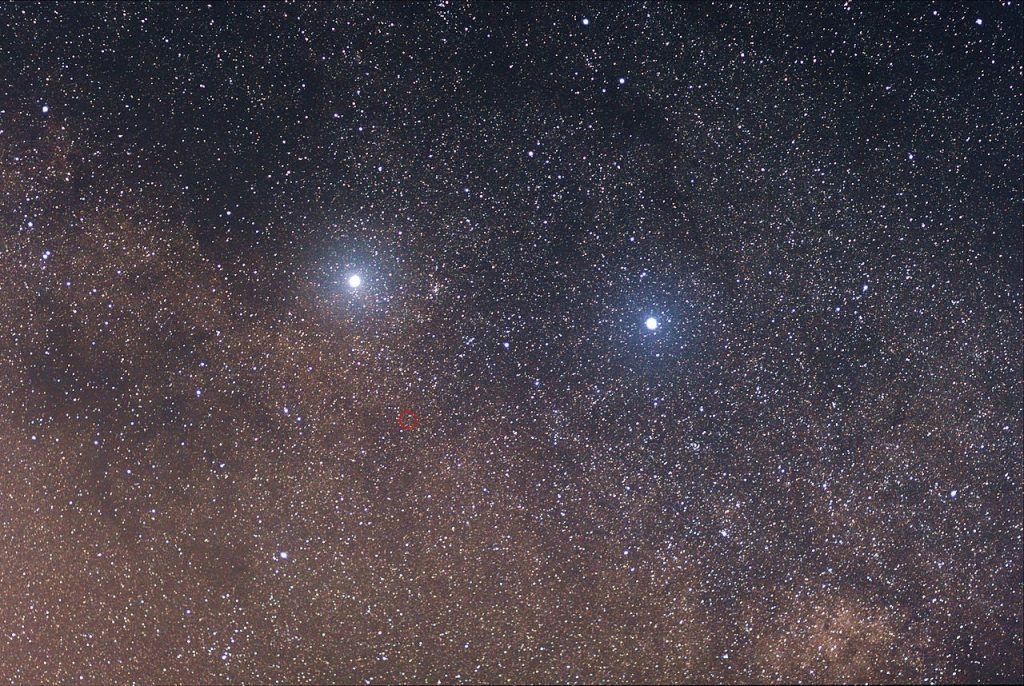Earlier this month, New Scientist reported that NASA has plans in the works to visit Alpha Centauri. While the plan is reportedly “nebulous,” the space agency hopes to launch something by 2069. Here’s what we know:
First things first: Why 2069?
The proposed launch date may seem an odd (if rather giggle-worthy) choice. But NASA didn’t just pull this one out of their butts: While setting the agency’s budget back in 2016, Representative John Culberson of Texas called for NASA to send a mission to Alpha Centauri by 2069. He didn’t pull that date out of his butt, either; It’s an homage to the centennial anniversary of the Apollo 11 moon landing. Nice.
If you feel like you’ve been seeing the number 69 all over your space news as of late, you’re right! New Horizons—the probe that flew past Pluto and is currently delving into the outermost regions of our fair solar system—has a 2019 encounter planned with a mysterious object dubbed MU69. You can find out more about how it wound up with that moniker here. For some reason, NASA is currently on the prowl for a good nickname for the celestial body.
What’s Alpha Centauri and why would we go there?
What with all the far-flung exoplanets scientists keep discovering using various telescopes, it’s easy to forget that we’ve only physically explored a very tiny corner of our galaxy. Voyager 1 only recently made it past the boundaries of our solar system. We literally just saw the first documented extrasolar hunk of space rock come careening through our neighborhood.
The sad truth is that outside of our solar system, we don’t exactly have any close neighbors. The closest star system is Alpha Centauri, and it’s more than four light-years away. Alpha Centauri A and B are two stars twirling as a binary pair, but their third sibling—Proxima Centauri—is the closest. It’s actually pretty far from the other two (about 13,000-times the distance between Earth and the sun), so a “mission to Alpha Centauri” would probably just be a mission to Proxima Centauri.
Getting to the next solar system over is admittedly a pretty logical step in the whole space exploration thing. We got our feet all over the moon (and may do so again, if the President has anything to do with it), we’ve taken pretty pictures of all eight planets (and then some), and we’re planning probes to test the waters on potentially habitable ice moons. Shouldn’t we get some of our hardware out of the kiddie pool and into interstellar space?
Proxima Centauri carries the added benefit of at least one confirmed exoplanet, which may be rocky (read: vaguely Earth-like). It’s possible we could find life there, or at least learn something about how easy it is for life to evolve.
Will there be aliens?
Generally, if a planet has a rocky surface and liquid water, we consider it potentially habitable. We’ve only got one example of life to work with, and we know that water is pretty dang important to everything alive on Earth.
Because Proxima Centauri is a red dwarf star, its habitable zone—the range a planet can orbit in while maintaining liquid water—is much smaller than our own star’s. But it seems like at least one potentially rocky little planet is in that area. We still don’t know much about the planets and/or moons there, so it’s really too soon to say what we may or may not find. One would hope that we’ll know a little bit more by 2069. A private project called Project Blue intends to launch a space telescope capable of imaging the system by 2019.
How long would it take to get there?
That’s the tricky bit. Using our current technology, it would take a very, very long time. The New Horizons spacecraft travels at over 36,000 miles per hour, and that’s pretty much the bee’s knees in terms of speedy cosmic travel. But it would take a spacecraft like New Horizons around 78,000 years to reach Alpha Centauri. I’m all for planning ahead, but if we haven’t gotten people into interstellar space in 78,000 years, I’m quitting. Whether we invent warp drives or go extinct, such a spacecraft would surely become obsolete before reaching its destination.
NASA’s job is to find a faster way. That 2016 directive to shoot for the stars also specified that the agency should create a spacecraft for the job capable of traveling at 10 percent the speed of light. That would get us there in around 44 years.
Can we actually do that?
Maaaaaaaaaybe. There’s no reason to think it definitely can’t be done. The good folks at NASA aren’t even the only ones trying: A few years back, billionaire Yuri Milner launched an an initiative called Breakthrough Starshot to create a Centauri-bound probe. Starshot wants to create a light-propelled nanocraft—just a few grams of ship, shot into space with a giant laser pushing at its solar sails. In theory, this is possible. But we’ve got a long way to go.
NASA is supposed to work on this and other potential propulsion methods, none of which are anywhere near ready for primetime. In fact, none of them are above Technology Readiness Level (TRL) 1 or 2. That means we just know the basic principles that could make the propulsion systems work, or perhaps have some broad sketches of how we would harness those principles. A successful mission is TRL 9.
In other words, don’t hold your breath. But hey, 52 years is a long time. Maybe in 2113, humans will be eagerly awaiting confirmation of our first exoplanet probe’s arrival. Of course, it’ll take over four years for that signal to get back to us.









